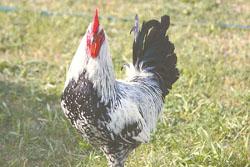
Most people have never heard of or seen an Iowa Blue chicken, but a few breeders are working to change all that. They’re selectively breeding and selling eggs, chicks and hens as fast as they can supply them to anyone interested in helping to preserve the nearly 100-year-old breed.
A true Iowa Blue has slate-colored legs and feathers that glow with a blue iridescent sheen on a unique white-laced pattern, says Connie Hurley, a fan of the colorful chickens she “discovered” in 2011. Initially the Iowa native was attracted to them in part because of their name. But their traits also match exactly what she was looking for.
“They’re good free rangers, they’re gorgeous, and I really want to support the breed,” she says. “The females really shine; they’re the prettiest. And the roosters are very majestic, proud and hardy.”
While she has lost a couple of other chicken breeds due to Wisconsin’s summer heat and humidity, the Iowa Blue flock thrives in both the heat and Wisconsin’s frigid winters.
She’s been impressed with the breed’s awareness of predators, such as hawks, and how a rooster fights to defend its flock. The birds free range during the day and stay in a coop at night for protection from fox and other predators.
While they fight predators, the roosters are friendly and good around people - even children.
“They’re active and animated and don’t do well in close confinement, preferring to free range. They’re a little more wild (than other breeds),” Hurley says, noting that the chicks hatch out active and “pop up with a gamey attitude”.
That trait might be traced back to the bird’s ancestry. The legend is that in the early 1920’s, John Logsdon, a Decorah, Iowa, farmer who loved to experiment, successfully bred a Chinese cock pheasant with a Black Minorca hen and a Rhode Island hen.
However the bird was bred, it was an ideal homestead bird that provided both eggs and meat for the table. The Iowa Blue breed nearly went extinct several times as commercial egg layer breeds dominated the market. Hurley credits conservationists such as Sand Hill Preservation Center for keeping the breed going.
Some characteristics such as size, coloring and egg quality have diminished, however. At the end of 2012, several Iowa Blue breeders organized the Iowa Blue Chicken Club to research and record the history, and to selectively breed back size and other characteristics. Hurley, who serves as secretary for the group, says members have made good gains in a short time. She has been busy dispersing Iowa Blue eggs and chicks at affordable prices to many of her Wisconsin neighbors.
Iowa Blue chickens fit the needs of people interested in raising small backyard flocks for eggs and meat. And with their lustrous plumage, unique pattern and proud, showy attitude, they’re gaining popularity at shows, Hurley says.
She suggests that anyone interested in the breed check out the club’s website, www.iowabluechickenclub.com and join in the Iowa Blue discussion thread on www.backyardchickens.com.
Contact: FARM SHOW Followup, Connie Hurley, Cedar Creek, P.O. Box 135, Palmyra, Wis. 53156 (cedarcreekWI@gmail.com; www.cedarcreekpoultry.weebly.com).
1-800-834-9665
Bringing Back The Iowa Blue Breed
FARM SHOW Magazine » Bringing Back The Iowa Blue Breed
Bringing Back The Iowa Blue Breed
